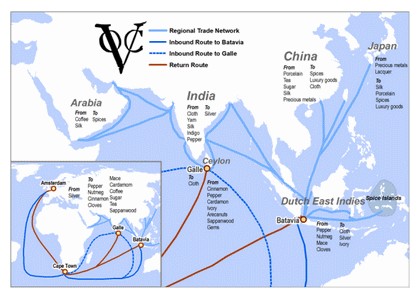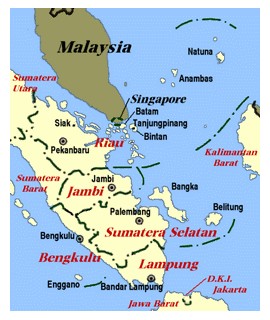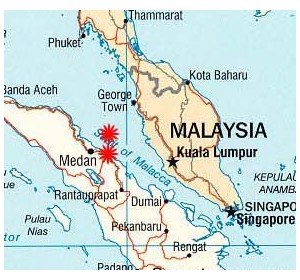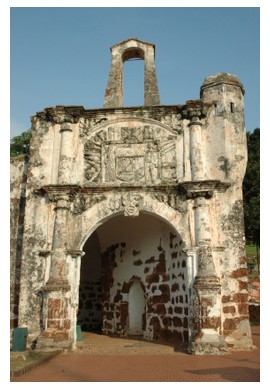- Early History of Malaysia
- Melaka Kingdom
- Portugal Rule
- Dutch Rule
- British Rule
- Malaysia during Second World War
- Malayan Emergency
- Independence
- Battle of Borneo
- Modern History

| |||||||||
|
History of Malaysia
"A simplified version of Malaysia's History"
You will read about:
When you go backpacking in Malaysia, you will notice the cultural diversity in the country. The question that will likely pop into your head is: So how did Malaysia become a multi-ethnic country? Hah...read the article and find out! Melaka was a also very important trading state. But what happens when a state as Melaka turns into a money magnet ? ... It attracts colonization and greed! Read this exciting article and learn more about Malaysia's background! You won't regret it! Early History of Malaysia
Buddhist and Hindu cultures imported from India, dominated the early Malay history. By about 900 AD the state comes under the rule of Srivijaya Empire, an Indianized kingdom. According to some historians, this is one of the first Indian marks in the history of Malaysia. Srivijaya is the earliest recorded Malay kingdom on the island of Sumatra (an island in the Western Indonesia). Around 1025: The Chola King, Rajendra Chola the First, from South India decide to go on several expeditions to Indo China (including Malaysia). The Chola king occupies the province of Kedah from Srivijaya, and continues attacks and raids through Malaysia and Indonesia. Later it turns out that the Chola invasion is unsuccessful, but the Srivijaya has still been weakened. This leads to formation of regional kingdoms in Malaya. In addition to Pelambang, Jambi is suggested to be the other power which eventually took over Srivijaya Empire. Srivijaya Empire ceased to exist between 1200 and 1300.
Around 1200/1300 centuryMajapahit Empire (an empire based on the island of Javal in today's Indonesia) takes over the kingdom of Malaysia. When Hayam Wurik, the ruler of Majapahit dies, the empire loses its power. 1400 Melaka Kingdom founded
I'll tell you why... Thanks to its strategic position, it acts as an important port of traders to and from China and India, through the Straits of Melaka. During this period, Melaka Sultanate is ruled by a Malay-Hindu prince, Parameswara who originally comes from Temasek (today's Singapore). The Melaka Sultanate stretches from today's Southern Thailand (Pattani, Phuket and Satun) to north of the Sumatra. Around 1400-1500 - Rule of Portugal
Some say that Islam was already introduced to Malaysia in the 10th century, while other historians say that Islam was established in the Malay Peninsula through Indian Muslims and Arab traders in 14th-15th century. We do know that Islam had a huge impact on the Malay people... But then... After the arrival in India, Portugal realizes the importance of Melaka. The Portuguese set out on an expedition in 1509, and many of the Portuguese are captured and put in jail by the Sultan Mahmud Shah. 1511: After the failed mission in 1509, Afonso de Albuquerque leads another expedition with the purpose to free the imprisoned Portuguese. After multiple attacks, Melaka is finally conquered by the Portuguese and the Sultan escapes. Portugal controls now the main Asian trade routes. The three key-points are Melaka, Goa and Hormuz (Hormuz in today's Persian Gulf). The old Sultan of Melaka, which is based in Johore, sets up frequent attacks on Melaka during the 1500s. During this era Albuquerque builds a fortress (called A Famosa), a church, a hospital for the poor, and Portuguese artists and merchants settle down in Melaka.
1600s - Melaka under Dutch ControlAs we stated earlier, Melaka is a powerful trading state which includes trading of precious spices. Dutch East India Company feels threatened when the English East India Company establishes trading posts in today's Indonesia. So, the Dutch, who are doing well in establishing overseas colonies, start blocking Melaka by sea.

image credit: people.hofstra.edu 1606: The Dutch and Sultanate of Johore form an alliance against the Portuguese. Johore was once part of the Melaka Sultanate until the Portuguese conquered the Melaka in 1511. 1641: After countless of useless attempts of conquering Melaka, Dutch finally defeats the Portuguese. But that didn't go easy It seems that the Dutch is so desperate that they offer the Portuguese the "white flag." After some consideration, the dying Portuguese commander accepts the surrender terms. As part of the Dutch/Johore agreement, the Dutch takes control over Melaka and agree not to occupy territories or wage war with Johore. Return to top of History of Malaysia 1700s and 1800s - British RuleThe British influence in Malaya starts with the East India Company, an early English company which started to trade with the East Indies and eventually China. 1771: The Sultan of Kedah wants help from the British to defend his territory against the Bugis (an ethnic Sulawesi group). 1786: The Sultan offers Penang Island as useful land to the Company. In 1800, Penang and a strip along the mainland comes under the Company's control. How did the Dutch lose their power over Melaka? As I've understood the shift of power in Malaya, France attacked the Netherlands in 1794 as a result of the France/British war in Europe (part of the Napoleonic wars). Prince William of Orange (leader of the Dutch revolt against the Spanish) flees to England. He gives instructions that the Dutch overseas (including Malaya) should allow the British to take over their posts on the understanding that they would be restored after the war. So, this leads to the fact that the British takes Melaka from the Dutch in 1795. 1819: The British occupies Singapore and this leads to political tension between the British and the Dutch. This political tension is solved through the Anglo-Dutch treaty, which is signed in 1824. The Anglo-Dutch treaty is about the political/territorial issues which arise from British occupation of Dutch properties during the Napoleonic wars, and one of the terms is dividing Malaysia between North and South. The British controls the North, while the Dutch is in the South (known as today's Indonesia). 1826: The British gather Penang, Singapore and Melaka into one administrative unit, called the Colony of the Straits Settlements. The Straits of Settlement opens job opportunities for Indian workers and traders. So more Indians immigrate to Malaysia...
Sarawak and Sabah
"Thanks for helping Brunei in their fight against piracy and rebellion. When it comes to Sabah, it was part of the Sultanate of Brunei in the 16th century. In brief, the Sultanate of Sulu is given Sabah as a compensation for his help on settling a civil war in the Sultanate of Brunei. Then private traders purchase Sabah from Sultan of Sulu between 1877 and 1878. Sultan of Sulu was a Muslim state which stretched from certain parts of the Philippines to Sabah. How does the British influence Malaysia? British power extends to the North, to the provinces of Perlis, Kedah, Kelantan and Terengganu. The British becomes involved in Malaysian life; from education to political aspects. British involvement makes sure that Malaya's economy goes well. An export of tin explodes when the British stop charging duty on imports on tin. And then in the early 20th century, the rubber industry escalates. On top of this, oil industry in Singapore makes sure the money keeps flowing. While the economy is flourishing, many Chinese come to Malaysia to work.
1941-1945 - Malaysia during Second World WarAs with other Southeast Asian countries, the Japanese started their conquest of Malaysia. The Japanese invasion leads to the formation of guerilla organization Malayan People 's Anti-Japanese (MPAJA) which is secretly trained and aided by the British. MPAJA starts fighting off the Japanese! When Second World War ends, so does the occupation of the Japanese. But a new conflict starts 1948-1960 -- Malayan Emergency
How do you imagine the aftermath in Malaysia after Second World War? Malaysia's economy has been disrupted by Hitler's war and leads to massive unemployment. Unemployment leads to protests. And some of the protestors become engaged in guerilla warfare. Parties like MCP are outlawed. The MCP retreat and form the MNLA (Malayan Races Liberation Army) with around 500.000 ethnic Chinese, some Malays and Indians. The leader of the MCP is Chin Peng. Hell unleashes They start a guerilla warfare targeting tin mining and rubber plantations, and destroying infrastructure and transportation.
In 1951 the MNLA kills the British High Commissioner, Sir Henry Gurney. As you can imagine, this leads to fear against the MNL among the Malays. In September 1955 the Government of the Federation of Malaya issues a declaration of amnesty to the Communists. Chin Peng wants to talk peace with the Government, but he's rejected by the Government members because they don't agree to Peng's terms. The conflict escalates ... and countries like New Zealand gets involved by sending their military forces to Malaysia. ...and the amnesty is withdrawed. During this period the MCP makes several efforts to talk peace with the Government. But this doesn't turn out to be successful. The last attack from the MNLA was in 1958, and the remains flee to the Thai border.
1955-1956 - Road to Independence
|
Search this site
Books on
|
||||||||
|
Connect with
| |||||||||
|
|
|||||||||









